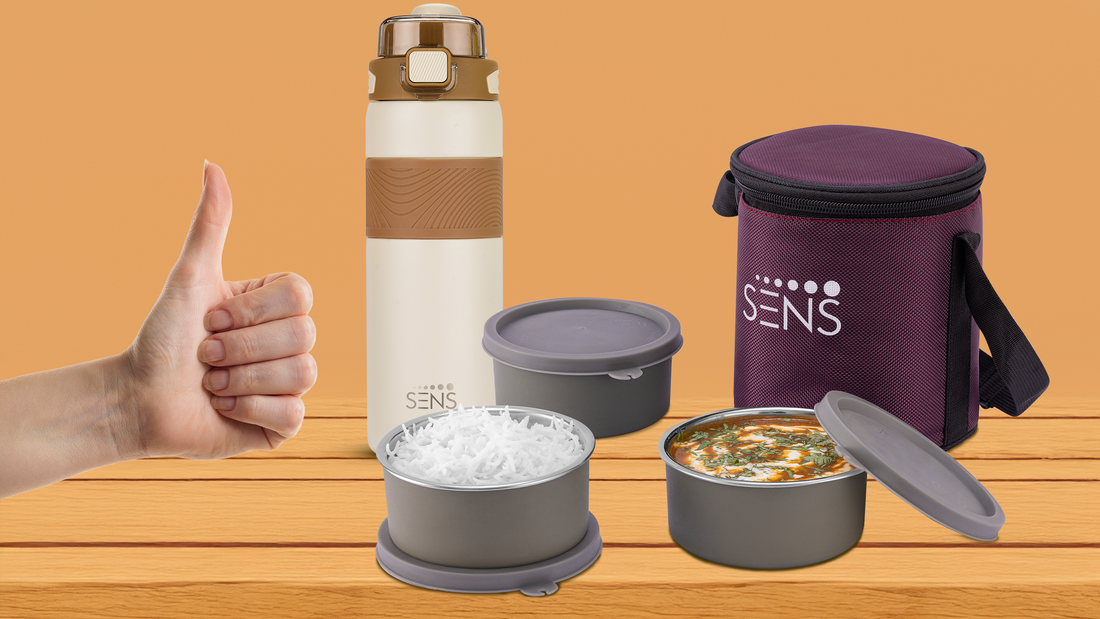
The Ultimate Guide to Choosing Your Perfect Lunch Box & Bottle
The Perfect Lunch Box: More than Just a Container
Gone are the days of flimsy plastic containers. Today's lunch boxes are innovative, stylish, and designed to meet diverse needs.
1. Material Matters:
- Plastic: Lightweight, affordable, and widely available. Look for BPA-free plastics (often marked with "BPA-free"). While convenient, they can stain, retain odours, and may not be as durable as other options.
- Stainless Steel: Durable, rust-resistant, and non-toxic. Excellent for keeping food hot or cold, and they don't retain odours or stains. They can be heavier and often more expensive upfront.
- Glass: Microwave-safe, oven-safe (without lid), and doesn't stain or retain odours. Great for reheating food directly. However, they are heavier and breakable.
2. Size and Capacity:
- Portion Control: Consider how much food you typically eat. Do you pack a main meal, or do you include snacks and sides?
- Meal Type: Will you be packing a sandwich, a salad, a snack or a multi-component meal?
- Age: Kids' lunch boxes are often smaller with fun designs, while adult sizes vary widely.
3. Compartments and Dividers:
- Integrated Compartments: Ideal for keeping different food items separate and preventing sogginess (e.g., salad with dressing on the side, main dish with a side of fruit).
- Removable Dividers: Offer flexibility to customize the space as needed.
- No Compartments: Best for single-dish meals.
4. Leak-Proofing:
- Silicone Seals: A common and effective mechanism for preventing leaks.
- Locking Lids: Clips or latches that secure the lid tightly.
- Ventilation: Some lunch boxes have vents, which are useful for reheating food in the microwave, but ensure they can be sealed for transport.
5. Insulation:
- Insulated Lunch Bags: Often made with an insulating layer to keep food hot or cold for longer.
- Thermos-Style Lunch Boxes: Designed specifically to keep liquids or solid foods hot or cold for several hours.
6. Ease of Cleaning:
- Dishwasher Safe: A major time-saver.
- Wide Openings: Make handwashing easier.
- Simple Design: Fewer nooks and crannies mean less food can get stuck.
7. Portability and Aesthetics:
- Handles/Straps: For easy carrying.
- Compact Design: To fit into bags or backpacks.
- Style: Choose a design and color that you like and that fits your personal aesthetic.
The Perfect Bottle: Hydration On-the-Go
A good water bottle is essential for staying hydrated throughout the day.
1. Material Matters:
- Stainless Steel: Excellent for insulation, keeping drinks cold/hot for hours. Durable, doesn't retain flavors, and easy to clean. Can be heavier.
- Glass: Pure taste, doesn't absorb odours or flavors. Heavier and breakable.
- Plastic: Lightweight, affordable, and comes in various designs. Look for BPA-free options (often marked with "BPA-free"). Can sometimes retain odors or flavors over time.
2. Size and Capacity:
- Daily Needs: Consider how much water you typically drink and how often you'll be able to refill.
- Portability: A smaller bottle might be better for a quick errand, while a larger one is ideal for a full day out.
3. Type of Lid:
- Screw-Top: Simple, secure, and leak-proof, but requires unscrewing each time.
- Flip-Top/Straw Lid: Convenient for quick sips, often one-handed operation. May be less leak-proof than screw-tops.
- Spout Lid: A smaller opening for controlled pouring or drinking.
4. Insulation:
- Vacuum-Insulated (Double-Walled): The gold standard for keeping drinks hot or cold for extended periods.
- Single-Walled: Lighter but offers no temperature retention.
5. Ease of Cleaning:
- Wide Mouth: Easier to clean with a brush.
- Dishwasher Safe: Check the manufacturer's instructions.
- Simple Design: Avoid intricate parts that can trap residue.
6. Ergonomics and Portability:
- Shape and Grip: Choose a bottle that's comfortable to hold.
- Carrying Loop/Handle: For easy transport.
- Fits in Cup Holders: If you'll be using it in a car.
Putting It All Together: Your Perfect Match
To choose your ultimate lunch box and bottle, ask yourself these questions:
- What kind of food and drinks do I typically pack? (Soups, salads, sandwiches, hot meals, cold drinks, etc.)
- How much food/drink do I need to carry?
- How important is temperature retention?
- How will I be transporting my lunch box and bottle? (Backpack, briefcase, hand)
- What are my cleaning preferences? (Dishwasher, hand wash)
- What is my budget?
- Do I have any specific health or environmental concerns? (BPA-free, sustainable materials)
By thoughtfully considering these factors, you can select a lunch box and bottle that perfectly complement your lifestyle, ensuring delicious, healthy, and convenient meals wherever you go.
